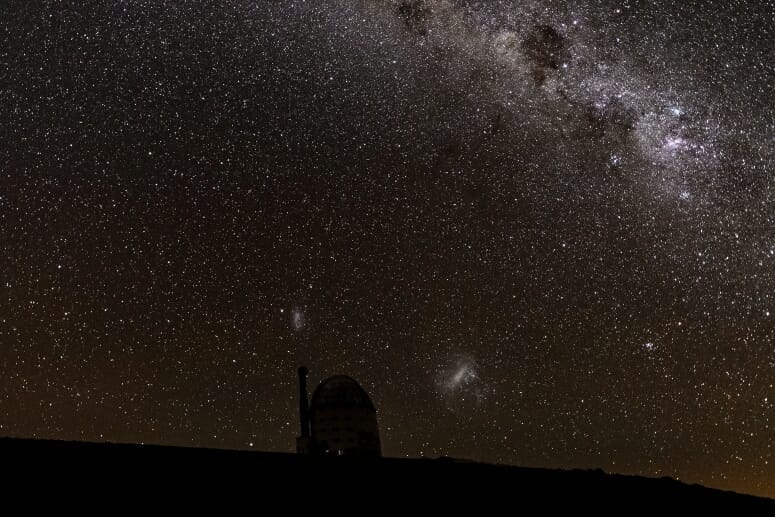Mar 29 2018
A 300,000 light-years long cloud of gas has been arching around the Milky Way, deflected away from two dwarf galaxies, the Large and Small Magellanic Clouds, orbiting our galaxy. For many years now, astronomers have made efforts to find out which of the two galaxies is the source of the gas discharged when they exert gravitational pull over each other.
The answer to this question will assist astronomers in gaining insights into the formation and transformation of galaxies, including our own Milky Way, over time.
 The Milky Way and the Large and Small Magellanic Clouds (at bottom) pass in the night sky above the Southern African Large Telescope (SALT) in South Africa. (Image credit: Jeff Miller)
The Milky Way and the Large and Small Magellanic Clouds (at bottom) pass in the night sky above the Southern African Large Telescope (SALT) in South Africa. (Image credit: Jeff Miller)
Astronomers at the University of Wisconsin–Madison collaborated with colleagues at the Space Telescope Science Institute and other institutions to use the Hubble Space Telescope to investigate the stream of gas. The researchers determined the chemical composition of the gas, called the Leading Arm of the Magellanic Stream and identified that one branch originated from the Small Magellanic Cloud.
The outcomes of the study indicate that the Large Magellanic Cloud is the winner of a gravitational tug of war with its smaller ally and will assist in refining models of the complex orbit controlling the motion of the dwarf galaxies.
We still don’t know how the Milky Way has formed. We have this huge amount of gas sitting around the Milky Way, and we still don’t know its origin. Knowing where it comes from helps us understand how galaxies form, including our Milky Way.
Elena D’Onghia, Professor of Astronomy at UW–Madison & Co-Author
The Magellanic Clouds can be seen with the naked eye from the Southern Hemisphere, and look like fuzzy offshoots of the Milky Way, around which they orbit. In the 1970s, they were determined to be the source of a huge stream of matter—the Magellanic Stream, including the Leading Arm—that could be observed to encircle the Milky Way disk. Subsequent to its discovery, Blair Savage, an emeritus professor of astronomy at UW–Madison, performed decades of studies to gain insights into the gas complexes around the Milky Way, including the Magellanic Stream. He signed up many young scientists to deal with the difficulty during their training at UW–Madison.
Co-authors of the new report include six of the earlier mentees of Savage, several of whom have since joined other institutions.
“He’s really the core reason that this all happened in Wisconsin,” stated Bart Wakker, a senior scientist in the UW–Madison astronomy department who joined Madison to investigate the interstellar and intergalactic medium along with Savage in the 1990s.
“There’s been a question: Did the gas come from the Large Magellanic Cloud or the Small Magellanic Cloud? At first glance, it looks like it tracks back to the Large Magellanic Cloud,” explained Andrew Fox of the Space Telescope Science Institute in Baltimore, who is the lead author of the study and a former graduate student of Savage. “But we’ve approached that question differently, by asking: What is the Leading Arm made of? Does it have the composition of the Large Magellanic Cloud or the composition of the Small Magellanic Cloud?”
To identify the chemical makeup of the Leading Arm, the scientists determined four quasars, or ultra-bright galactic centers, that exist behind the stream of gas. Then, by using the Hubble Space Telescope, they collected ultraviolet light from the quasars when it filtered through the Leading Arm. The researchers integrated the ultraviolet light data with measurements of hydrogen made using radio data. The results indicated an abundance of sulfur and oxygen characteristic to the Small, as opposed to the Large, Magellanic Cloud.
Such a similarity in chemical composition indicates that the Leading Arm was gravitationally dragged away from the Small Magellanic Cloud, probably over a billion years earlier. Earlier research outcomes seemed to indicate that the Leading Arm is part of the Large Magellanic Cloud, which implies that the sources of the galaxy-sized stream of gas might be complex.
The scientists remarked that the new study leaves open questions related to the destinies of the dwarf galaxies and the matter discharged from them.
“The whole point of this work is to understand what is happening to the Magellanic Clouds as they begin to merge with the Milky Way and how the gas from the clouds mixes with the gas from the Milky Way,” stated Wakker. “And we’re really only in the beginning stages of understanding that process.”
The National Aeronautics and Space Administration partially supported this work through grants from the Space Telescope Science Institute.